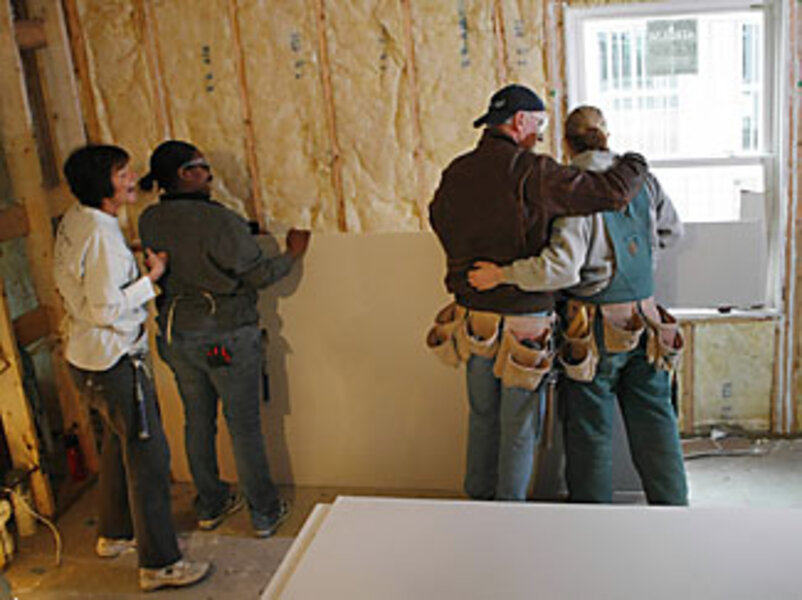Economic downturn frays America's safety net
Loading...
Is America's safety net in danger of unraveling? Many of the country's nonprofit organizations are on the front lines of the economic crisis, providing food and shelter, help in preventing foreclosures, job retraining. But they're being hit by the hard times, too.
As Congress digs in this week for negotiations on President Obama's $825 billion economic stimulus bill – with funds targeted to tax cuts, infrastructure, and state aid – people in and outside the nonprofit sector say it ought to be part of that package. Not only would this preserve jobs and shore up a crucial part of the US service-delivery network, they say, but would employ it most effectively in spurring an economic recovery.
"By including this sector we can take advantage of a huge network of institutions that work hard ... to improve the welfare of communities and individuals, that will spend the money quickly, that have the capacity to spread the dollars widely, and that in the absence of such help will need to shrink and thus become another drag on the economy," says Isabel Sawhill, senior fellow in economics at the Brookings Institution in Washington.
The US nonprofit sector employs 10 percent of the workforce – more than the auto and steel industries combined. The National Council of Nonprofits recently reported that revenues have "plummeted" as foundations, corporations, and state and local governments cut back on funding to nonprofits.
Some of the monies in the proposed stimulus bill – the American Recovery and Reinvestment Act – would trickle down to certain nonprofits through state and local governments.
But the process is likely to be slow and cumbersome, many say.
"If the money goes out through state and local governments, chances are there will also be leakage into other purposes along the way and not all the money will reach direct service provision," says Lester Salamon, director of the Center for Civil Society at Johns Hopkins University in Baltimore, and a former deputy associate director of the White House Office of Management and Budget.
The legislation, for instance, would give billions to states for the Medicaid program, and for "block grants" for social services and community development projects (states decide whom to fund).
"That's not a substitute for doing something to more directly and more speedily move money to the nonprofit sector," Dr. Sawhill says.
Several proposals to prevent the unraveling of the safety net are directed toward the entire sector, while others target specific needs.
"Nonprofits have an enormous potential contribution to make that policymakers tend to overlook," Dr. Salamon says. For example, he points to hundreds of low-income housing organizations and community-development credit unions across the country with a track record that demonstrates they could help resolve "the mortgage mess."
"They've developed systems for analyzing the income of [low-income] people and finding mortgage products they can afford. They've got billions of dollars in mortgages that are performing well – and are not experiencing the foreclosures that for-profit lenders have been experiencing," Salamon says.
These groups are equipped to work with families to ward off potential foreclosures. And, if the government is going to buy bad mortgages at 50 cents on the dollar and wants to get them up to 75 cents for the benefit of the taxpayer, he adds, they know how to do it. He'd like to see them put to work by the government's Troubled Assets Relief Program (TARP).
Various proposals made in recent weeks related to the stimulus bill or subsequent recovery legislation include:
•Invest 10 percent of the stimulus, or about $80 billion, directly in nonprofits. Sawhill proposes that these temporary funds be distributed across the sector in proportion to the amount each organization reported to the IRS for the prior year, with a cap on what a group could receive. This broad distribution makes sense, she says, because "the most important objective right now is an economic objective."
•Set up a short-term, $15 billion bridge-loan program to help human service providers maintain jobs and services. Some 300,000 jobs are at risk due to state and local government cutbacks and delays in reimbursements, says the Independent Sector, a coalition of 600 charities.
•Utilize the Emergency Food and Shelter Program to get federal dollars quickly and directly to community services. In this program, which is used during disasters, money goes out through a network overseen by a board of charities to local committees that have public-private representation, Salamon says.
Others say community foundations could be a natural route for distributing funds. "This would give flexibility to local communities to see what needs are not being met and to get some money to groups that are meeting those needs," says Aaron Dorfman, executive director of the National Committee for Responsive Philanthropy.
•Create at least 175,000 new jobs in national service, and a matching-grant fund to spur new investments from philanthropy along with federal dollars.
A number of national service organizations have joined to propose these ideas. (The proposed legislation does include money to expand AmeriCorps by 16,000 members.)
There have also been calls for changes in law or regulations that would (1) require foundations to spend 10 percent rather than 5 percent of their assets annually for the next few years, or (2) provide generous tax credits for a period of time to spur more individual charitable giving.
Some of these recommendations were presented to the Obama transition team. Many in the sector are hopeful, given the president's own experience at the grass roots and his stated commitment to a public-private partnership. A main concern is that the scope of the economic challenge – and the persistent crises in the financial system – could get in the way of putting that partnership to work.





